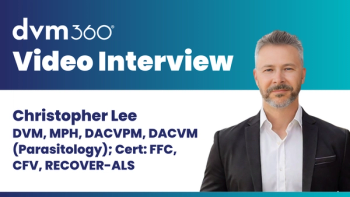
- dvm360 July 2022
- Volume 53
- Issue 7
Colic surgery delivers a painful reminder
Find out what happened to Dr. Bo Brock after being kicked by an anesthetized horse
For the past 30 years, colic surgery in the middle of the night has been an unchanging ritual at Brock Veterinary Clinic. And for 20 to 25 of those years, I was the only veterinarian there that could do them, so I was up all night 1 to 5 times a week. But the years have passed, and now there are 4 of us able to do them. My up-all-night life has settled down quite a bit. Thank goodness.
However, one event from a few years ago has never left my memory bank. It was about 3 AM when we were finishing a colic surgery on a precious old mare. If you have never seen how a 1200-lb horse is moved from the induction room to the surgery table and then back to the recovery room, well, it is quite a thing to behold. We have a giant U-shaped I beam welded to the ceiling. A 2-ton hoist on it picks the horse up, upside down, by hobbles on their ankles, and we push them from place to place.
As we pushed the upside-down mare from the surgery table to the recovery room, something terrible, something that I have always dreaded, happened…the hoist died. The mare was about 18 in off the ground when the hoist made a spark or two and gave up the ghost. Oh man, what to do now?
We packed thick and cushy pads underneath the mare, and then I began the arduous process of cutting the material that made up the bulk of the hobbles. Those things are tough. I mean, really tough. My pocketknife was doing almost nothing to them, so I got a few large scalpel blades and started hacking my way through.
You would think if I were going to be kicked by a horse, it would be when it was awake. I work on horses all day, every day, and I have learned to read a horse’s warnings that suggest if I keep messing with them, they are going to kick me. You can’t see those signs in one that is hanging upside down at 3 AM.
When I finally cut the back hobble enough that it broke through, I was not at all prepared for what happened next. The horse’s fanny fell about 18 in onto an 18-in-thick pad. How could that be dangerous? Well, let me tell you, those pads had a lot of bounce to them. The horse’s back legs were straight and fixed that way. When 600 lb of horse posterior hit those springy pads, one of those legs whipped around in a circle at the speed of sound. On recoil, it smashed me in my fat tummy before I could even try to dodge.
This knocked all the air out of my body, leaving me piled up in the corner, wishing I were a person who cussed more. It hurt. But in a few minutes, I was back in the game. We got the horse down, and everything went well from there.
Getting on with business
Three days later, however, I still had pain in my tummy. It was accompanied by a soft spot just to the left of my belly button. I figured this was not good. And it wasn’t. I called my friend, a human soft tissue surgeon who brings horses to me. I told her about the event and the worrisome soft spot next to my belly button. She made me an appointment to see a physician, and off to Lubbock, Texas, I went.
The diagnosis was clear. “It is a hernia…best I can tell, it is about 8 inches long. The force of that horse’s foot tore your muscles. You need to get it fixed soon. I will set you up for surgery in a couple of days,” the physician said.
Driving home from the appointment, I thought I could be the only vet in the world who was kicked so hard by an anesthetized horse that he required surgery for a hernia. Sheesh.
The surgery required a 10-in mesh to correct the defect and a long lecture from my doctor that I should not lift anything weighing more than 10 lb for at least 6 weeks.
I went home to lick my wounds and lie around a while. Guess what? Thirty-six hours later, the doctor who fixed my hernia called my cell phone and said, “I have a [horse with] bad colic that I feel sure is going to need surgery. Can I bring it on down?”
“What?” I said. “You just told me 2 days ago not to lift anything heavier than a rump roast and you are wanting me to pick up giant horse guts that weigh at least 50 lb?” Funny how things change.
“I will scrub in with you and do all the heavy lifting. If you tell me what I need to do and what we are looking at, we can make it work,” was her reply.
I wasn’t worried about all that. What did worry me was the fact that my belly was painful and kept me in bed. I wasn’t sure I could stand up for a 2-hour surgery, much less pick up a horse gut packed with doo-doo.
She said if I would meet her there, she would put a system in my incision that would deliver lidocaine to the incision site so I would be able to stand up straight and help her. “Sure thing,” I said. If she had a way to make me feel better, I was in. I also wanted to help her horse.
We met at the clinic and the party started. She fixed up a system in my incision, and I felt like a million bucks. We worked as a team to save the horse’s life that day. I was amazed. As I watched her do the surgery under my advice, I realized how good a surgeon she was. I mean, really good. It made me happy she had been the surgeon to fix my boo-boo.
The lidocaine didn’t last very long when she removed the system after the surgery. Let me tell you something: I was happy the horse had lived and I’d watched her do the surgery, but my surgery site was a painful rascal for the next few days.
After 35 years of being a vet, you never know where it will take you.
Bo Brock, DVM, owns Brock Veterinary Clinic in Lamesa, Texas. His latest book is Crowded in the Middle of Nowhere: Tales of Humor and Healing From Rural America.
Articles in this issue
over 3 years ago
Z is for zebras and other dental surprisesover 3 years ago
Practice ownership perksover 3 years ago
3 steps to protect your practice from ransomwareover 3 years ago
Hiring isn't all about moneyover 3 years ago
Dermatology image quizover 3 years ago
Protecting adopted pets from heartworm diseaseover 3 years ago
The A — Z on ADA complianceover 3 years ago
Managing feline behavior with modificationsNewsletter
From exam room tips to practice management insights, get trusted veterinary news delivered straight to your inbox—subscribe to dvm360.






